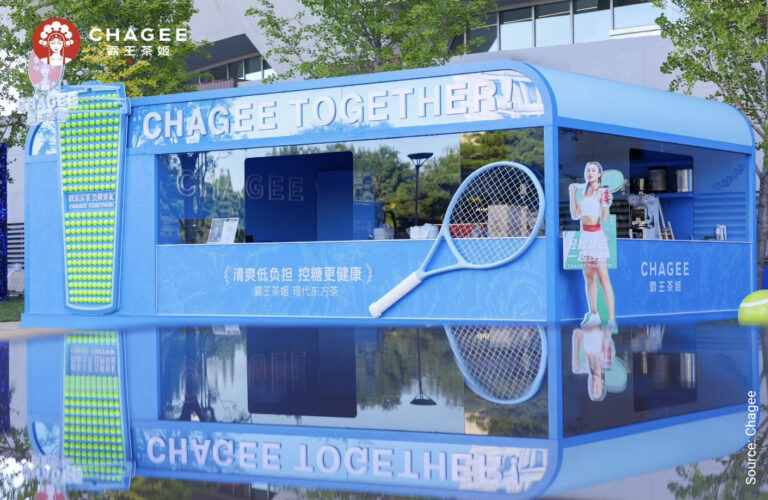How should brands communicate to Chinese customers during the Coronavirus outbreak?
While the epidemic is expanding globally, Chinese economy is gradually emerging from its lethargy. After the country’s quarantine has just ended, Chinese consumer behavior is no longer the same as before. During the epidemic, we have seen giant brands cutting down their operation like Ikea, Starbucks, and McDonald’s. The chain of events leads to the need of Coronavirus crisis management in China.
Crisis management in China have never been more critical for brands, which had to adapt their operation strategies to protect their employees and customers from contamination to stay afloat. From fast food to e-commerce, including AI and transport, here is an overview of the measures taken by leading brands in these industries to handle the coronavirus crisis, and how they bounced back
Didi’s Coronavirus crisis management in China: Keep driving through the epidemic
Reports of multiple drivers being diagnosed with the coronavirus affected China’s ride-hailing service market, while travel restrictions across the country had already hit the industry hard. Concerns have arisen over potential infections after a driver on Didi Chuxing, China’s largest ride-hailing company, was diagnosed with the coronavirus in early February. Under these not-so-favorable circumstances, Didi Chuxing has taken strategic steps for Coronavirus crisis management in China.
A special fleet for medical workers and citizens
After shutting down service provision in a range of cities including Wuhan and Beijing, the company has deployed two exclusive fleets of drivers dressed in protective uniforms with regularly disinfected vehicles. The 1,336 volunteer drivers operated in Wuhan, the epicenter of the outbreak, and in Shanghai to provide free transportation services to all hospital staff. Didi’s special fleet is said to have transported more than 9,500 medical workers in Wuhan and Shanghai. This measure is the first one to be listed in the “Didi on the frontlines, Didi in action” feature, directly accessible on the Didi application. The company also said to have RMB 200 million (around USD 28 million) mobilized for protective medical supplies and allowances for these fleets.
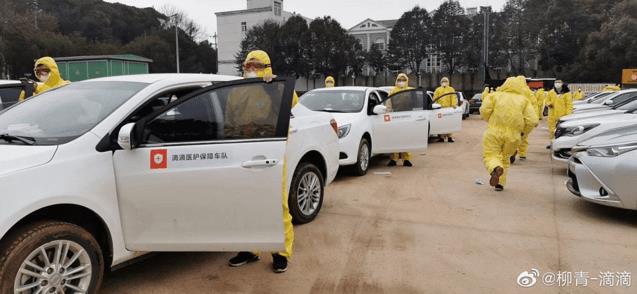
[Source: Didi, Weibo – The special fleet for medical workers in Wuhan]
The in-app feature is entitled ‘Your ride is protected, travel with peace of mind’, detailing rules to be followed by both drivers and riders to protect themselves from contamination including standards for masks, ventilation, and vehicle cleanliness. The ‘Safety Center’ of the application has been updated to include these safety rules. The company’s main communication channels, the Didi app and the Weibo social media account, followed by 3 million people, are mobilized to spread the messages from the company to the community. During the outbreak, Didi has posting daily on its Weibo account.

[Source: Didi app – Coronavirus crisis management in China]
Special measures for special drivers
In the boring-at-home times where scrutinizing and reacting to the news has become the main Chinese consumer behavior, an agile communication strategy in China is vital to keep control over one brand’s image. On February 4, Chinese social media Weibo ignited after a Didi driver was diagnosed with the Coronavirus. “Didi is in touch with the driver and will provide extra subsidy for him during the treatment,” the company said in a quick reaction on February 6. “We have provided relevant information to the local government and are working closely with them on virus prevention and control.” Following this measure, the company released a special insurance program providing a daily allowance up to RMB 30,000 (USD 4,300) for any driver who is hospitalized for the Coronavirus.
To enhance the safety of the drivers and passengers, the ride-hailing company opened ‘driver epidemic prevention service station’ in 106 cities across China to distribute face masks, disinfectant, and other anti-epidemic materials to the drivers.
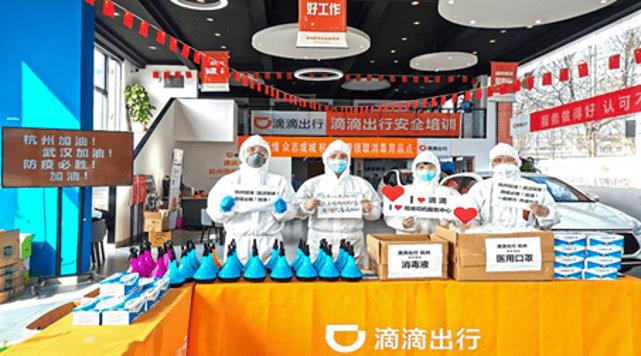
[Source: Didi, Weibo – one of the 106 ‘driver epidemic prevention service station’]
As the number of passengers drops during the epidemic, Didi wants to showcase that its cars remain the safest means of transportation. In order to further safeguard citizens’ safety on the road, DiDi introduced the “epidemic prevention” QR code, which includes the sterilization records and register information of each car. On the Weibo account, numerous pictures illustrate the disinfection of vehicles by the drivers.
The results of Didi’s crisis management in China
DiDi’s timely Coronavirus crisis response received positive feedback from society, strengthening DiDi’s brand awareness in China. The Huhhot government reported DiDi’s response to the coronavirus epidemic on February 29th, and praised its actions on preventing and control the disease.
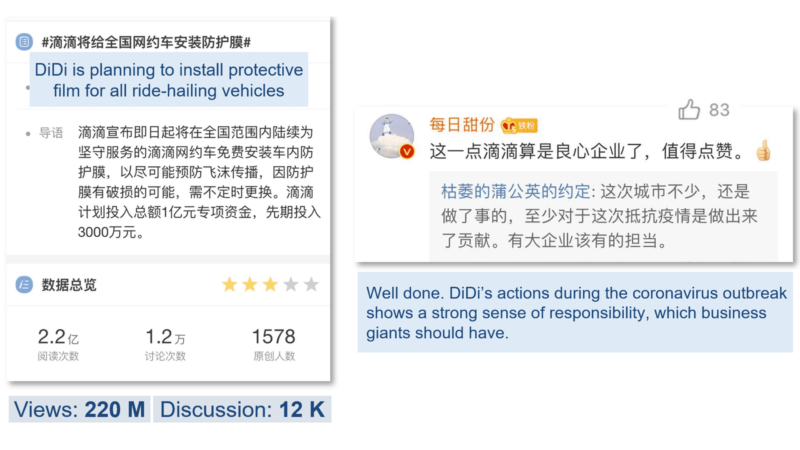
[Source: Didi, Weibo –Positive social reaction]
After DiDi announced to take actions to prevent the spread of the virus, a Weibo post about DiDi’s handling of the crisis went viral. Many Chinese netizens praised DiDi’s efforts to act as a socially conscious company. As of early March, since the virus has been under control in mainland China, resident trips in major cities has increased by more than 30%.
McDonald’s coronavirus crisis management in China: Safeguarded meals
“China is a critical market for us, and we’re very concerned about the situation over there” CEO of McDonald’s said late January. Adding its name to the list of global companies bracing themselves for the impact of the coronavirus outbreak, the American fast-food chain decided to shut about 300 restaurants localized in areas where the spread of the epidemic was significant. With 3,000 restaurants still in operation across China, what measures have been taken to ensure the safety of both employees and customers?
A special Coronavirus crisis management team to deal with the outbreak
McDonalds was checking the temperature of customers as early as January 2020. While the coronavirus crisis was in its infancy, the company was already well prepared to protect the health of its employees and customers. Thus, strict in-store prevention measures were taken such as equipping stores with hand sanitizer for customers and disinfecting frequently touched surfaces
According to its CEO, the American company decided to set up a special crisis unit to deal with the outbreak. Handling Coronavirus crisis management, the unit’s work has been witnessed through a specific communication strategy with a campaign called ‘放心送’, meaning ‘worry free deliveries’. Indeed, Chinese consumer behavior during the outbreak involves ordering delivery rather than going outside for lunch.

[Source: Eleme饿了么 – McDonald’s ‘放心送’ campaign to adapt Chinese consumer behavior during the epidemic ]
Contactless delivery during the Coronavirus outbreak in China
On February 1st, McDonald’s launched a contactless delivery service available on food ordering platforms such as Meituan美团, Eleme 饿了么, and its own application. As people rely massively on Meituan美团 and Eleme饿了么 to order meals, the company’s communication strategy in China has paid attention to get visibility on these third-party platforms. Following six epidemic prevention principles, the contactless delivery service aims to ensure the delivery of safe meals. Temperature is systematically checked, from the cook to the delivery person, restaurant and kitchen are regularly disinfected as well as the delivery box and the delivery bike. Employees are required to wash their hands and wear a mask. The meal is dispatched in front of the residences as deliverers are not allowed to make door-to-door deliveries. All delivery orders are accompanied by a ‘Safety Delivery Card’, which indicates the name and temperature of the prep and delivery staff.
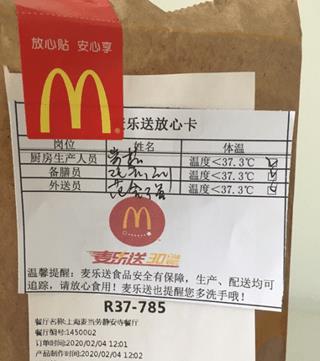
[Source: daxue consulting ‘Safety Delivery Card’]
Free meals for medical staff
Following Didi’s strategy to be present on the frontlines directly offering its core services, McDonald’s is offering free meals to medical staffs fighting against the coronavirus. One week after the opening of a dedicated restaurant in Wuhan, on February 3, the company announced on Weibo to have delivered around 3,500 free meals to support the battle.
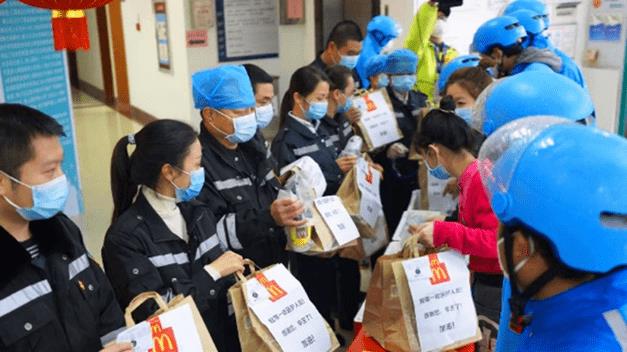
[Source: McDonald’s Weibo – Free meals distribution to medical workers in Wuhan, a key component of their Coronavirus crisis management strategy.]
The result of McDonald’s crisis management in China
Due to McDonald’s quick strategy adaptions, around 3,000 offline stores operated as usual during the coronavirus outbreak, which have minimized financial loss. To further support its customers, the company introduced a Big Mac Burger combo and named it as “助你一BIG之力” (‘spare no effort to help you’.) The combo only costs 20 RMB and was available from March 4 to March 24. To convey positive energy, McDonald’s started a topic called “助你一BIG之力” on Weibo, encouraging consumers to create DIY “cheer up” cards.
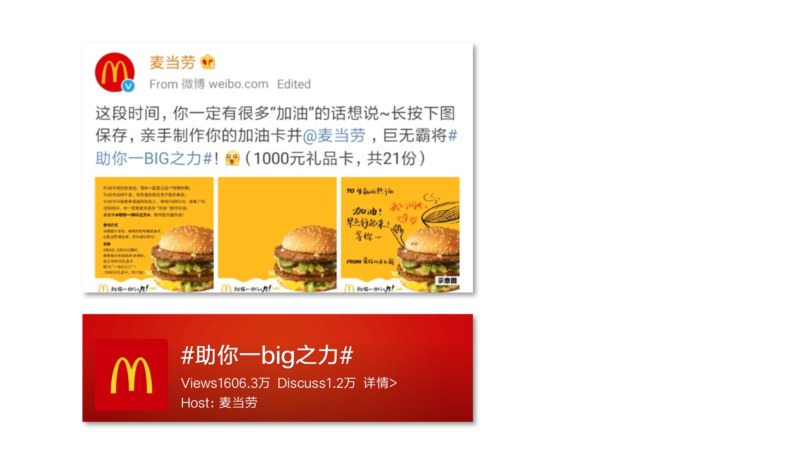
[Source: McDonald’s Weibo – DIY ‘cheer up cards’ and the engagement under the topic “助你一BIG之力” ]
The company has won respect and support from Chinese consumers, evidenced by their engagement to support the brand on the Chinese social medias. Under one of McDonald’s WeChat posts with 100k+ reads, one reader said she is greatly moved by learning the news that McDonald’s delivered free meals for medical workers, and she will continue to support McDonald’s.
McDonald’s once again proves that beyond the name and the symbol, it embodies the concept of Globalization: think global, act local. Indeed, its Coronavirus crisis management and communication strategy in Chinaare testimony to the brand’s capacity to successfully adapt to local market constraints.
Baidu’s crisis strategy – AI for a safer world
BBaidu, the tech giant that operates the country’s largest search engine, spares no effort to help those working to stop the Coronavirus outbreak. Predicting that the turnover in 2020 Q1 would fall by 5% to 13% compared with the same period last year, Baidu’s online advertising and marketing service sector is badly affected by the epidemic. However Baidu’s internet search solutions may benefit from the situation, since people are much more likely to do research and stay informed of new developments. Thus, from January 21 to 24, more than 1 billion people on average searched or browsed information on 2019-nCoV on Baidu every day.
Baidu’s crisis strategy during the Coronavirus involves AI and big data. In 2017 the company made no secrets of its ambitions to become the first global company in the Artificial Intelligence sector. Well, it seems that Baidu brilliantly took advantage of the recent events to show off its AI-fueled muscles, aiming to improve its brand awareness in China and beyond, in this specific field.
Baidu uses AI to predict virus’ secondary structure
On January 30, Baidu Research Institute opened up ‘LinearFold’, its RNA prediction algorithm, to global genetic testing agencies, epidemic prevention centers, and scientific research institutes, for free. The ‘LinearFold’ deep learning tool only takes 27 seconds to solve the RNA secondary structure of the 2019-nCoV — 120 times faster than the top classic algorithms. This tool, which could appear to the uninitiated as a gadget for biologists, is one of the latest breakthroughs in the medical field and an opportunity to better understand the virus and develop targeting vaccines.
New features to spread knowledge
On its search engine and map applications, the tech company has set up a powerful information center closely following the reported new cases and providing insightful trend data. The application menu shows real-time infected cases at several scale levels, evolution curves, location of the nearest hospitals, top researches of netizens on the virus, as well as options to take free online courses. The platform displays the number of visits to the information center, which reached more than 2.5 billion views.
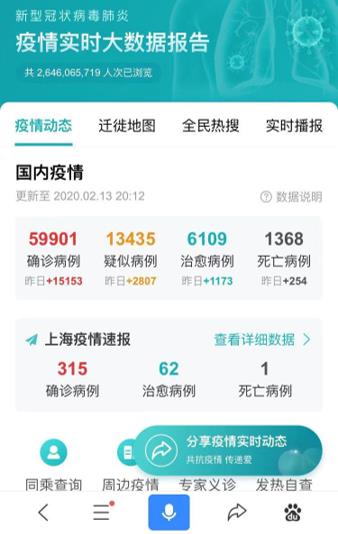
[Source: Baidu app – Information center about COVID-2019 m]
Among others, a new self-testing feature using AI and big data is available from February 11. After the user has entered basic information about his state of health, the tool reviews a new coronavirus pneumonia diagnosis and treatment scheme and combines many online consultation cases. For the better or worse, it gives diagnostic probabilities of infection.
Big data powered maps
The tech company has also integrated the coronavirus outbreak into its Map app, making it easier for people to avoid contaminated areas. The company had built a special ‘epidemic map’ which shows the location of both confirmed and suspected coronavirus patients in real-time.
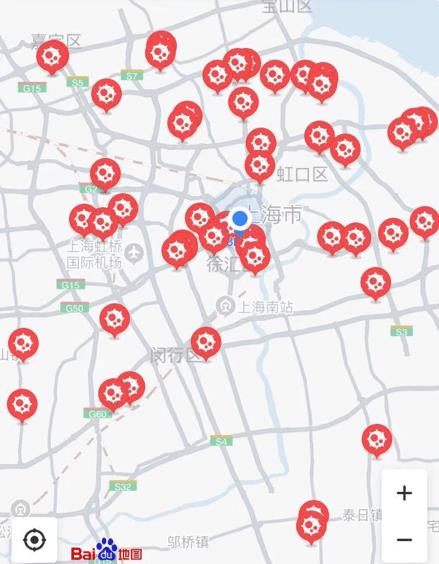
[Source: Baidu Map App – The ‘epidemic map’]
Another interesting tool is the ‘Migration Trend Map’ feature. People can check the migration status of all Mainland cities from the first day of the Spring festival to now. In 2018, it was estimated that Chinese travelers made around 3 billion trips during the 40-day Spring Festival period. The feature is useful when it comes to making travel plans to go back home at the end of the Chinese New Year and avoid the rush. After entering Baidu’s migration platform, people can select the ‘migration destination’ or ‘migration source’ of a city and view the graph of migration trends compared to last year’s one. While it’s not clear how the epidemic map collects data to ascertain the locations of the patients, the migration map is powered by the positioning data from users of the standard Baidu Map service, which has been densified to ensure privacy.

[Source: Baidu ‘Migration Trend Map’]
The result of Baidu’s crisis management in China
By being a resource for real-time information, the value of Baidu as an information portal has been highlighted. Since the coronavirus outbreak, over 1 billion people searched and read coronavirus related information through Baidu every day. As of March 20th, 651.6 million people had visited the “online diagnose” platform powered by Baidu health, and over 30 million people had consulted the platform. Therefore, recognized as a reliable information portal, the average daily active users of Baidu APP exceeded 20 million, a 10.4% growth compared with the same period in 2019.
JD.com – an opportunistic déjà vu
Just like nowadays, when the SARS virus swept through China in 2002-2003, it resulted in millions of workers isolating themselves in their homes. This phenomenon turned out to be pivotal for several now dominant e-commerce companies, such as JD.com.
The company was created in 1998 by Richard Liu, and initially sold magneto-optical products in the Zhongguancun High-Tech Industrial Park region of Beijing. By 2003, the company was thriving with 12 physical stores. However, the severe SARS outbreak threatened Jingdong’s future. Recognizing this as an opportunity to pivot the business, Liu quickly reconsidered his brick-and-mortar storefront and the possibilities for the same idea using an e-commerce model. The e-commerce platform became a big hit almost immediately, and JD.com was born.
The coronavirus outbreak hovers like a deja-vu for China’s biggest online retailer. Following a similar scheme as 15 years ago, JD.com is taking advantage of the epidemic to implement a based-on-innovative Coronavirus crisis management strategy.
Deliveries by drones and robots
It’s a unique opportunity for the company to soar above its competitors. JD reported its first successful delivery via drone in Hebei province on February 7th. The drone completed a delivery to a remote village, which delivery people used to reach with a boat, a route temporarily closed because of the outbreak. The day before, on February 6, JD’s autonomous delivery robot successfully made its first delivery to Wuhan Ninth Hospital, a designated hospital for the treatment of the novel coronavirus pneumonia in the epicenter of the outbreak. “JD autonomous delivery robots can help reduce human-to-human contact making them an ideal solution for last-mile delivery solution in Wuhan” said Qi Kong, Head of Autonomous Driving at JD Logistics
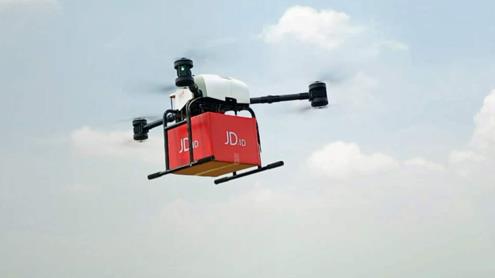
[Source: Freight Waves – JD’s drone completing delivery test]
Deliveries by drone and autonomous robots are not a brand-new service from JD.com, which already began daily operation in two test cities last year. These exploits, beyond its practical and beneficial effects to avoid contamination, are a part of a well-established communication strategy in China to exhibit the brand capabilities. The e-commerce company made videos of the two deliveries that are frequently shared on Chinese social media, as well as Twitter, LinkedIn, and Facebook.
Special measures for special deliveries
JD’s corporate website, Weibo and social media accounts detail other individual steps taken against the coronavirus. Like Baidu, the online player sometimes posts more than five times a day virus-related content on Weibo. Grateful to its delivery couriers, the company released the portraits of some of these ten thousand ‘heroes in red’ who were still working during the peak of the epidemic to meet consumer demand in China. Similar to Didi, the company stepped up the allocation of emergency materials for epidemic prevention, such as masks, thermometers, protective glasses and clothing, disinfectant, and a special insurance plan for its employees on the frontlines.
The Coronavirus crisis management of JD.com also welcomes AI as a powerful instrument to join the fight. On February 4, JD implemented its ‘smart epidemic assistant’ into the Wuhan Mayor’s Office WeChat account. The smart assistant, relying on AI capabilities, including semantic and syntax understanding, can automatically answer a wide range of questions from the Wuhan’s dwellers. Currently, it provides functions including epidemic self-screening, medical guidance, and even a way to inquire if a user’s flight or train had a coronavirus patient on it. Cloud and AI branches of the e-commerce giant also launched the ‘Emergency Resources Information Platform’ which provides municipal and medical institutions direct access to 3,000 online medical suppliers. As of February 4, the platform has performed the sourcing of more than 19 million protective face masks.
The result of JD.com’S crisis management in China
During the outbreak, JD.com made great contributions to ensure the stable operation of front-line assistance. Social responsibility and impressive logistics management allowed the brand to receive positive comments and obtain good reputation. For example, Dr. Zhong Nanshan – who discovered the SARS and is therefore widely recognized in China – wrote a thank-you note for JD’s “frontline medical assistance and urgent delivery of medical supplies to Wuhan.”
On March 2nd, JD.com published its 2019 Q4 financial report. After seeing the initial impact of the virus, JD.com still estimated an increase of more than 10% of the net income year-on-year in 2020 Q1. As JD.com continued increasing technology development, its anti-risk capabilities of the supply chain and logistics system have improved significantly.
Proper Coronavirus crisis management will improve brand awareness in China
Throughout the crisis, brands operating in China have demonstrated that they have a significant role to play in these times of public health challenges. Many of the brands have put robust measures to ensure the safety of their employees to ensure the business continuity – sometimes with great financial consequences. Overall, brands’ communication strategy in China show an understanding, caution, and optimism, which reflect trust in the future.
It’s precisely because there will be a future that brands, dare to innovate by engaging their core competencies in their China crisis strategies. Seizing crisis as an opportunity to show to the world that they not only have social duties, but also an increasing positive social impact. As China’s economic recovery from COVID-19 continues, it is now in the hands of other countries to figure out the best crisis management strategies.
Author: Maxime Bennehard
The ultimate Coronavirus economic impact in China report
Everything you need to know about the coronavirus by daxue consulting from Daxue Consulting



